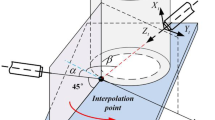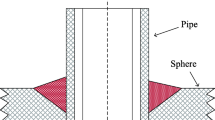Abstract
Welding path planning and motion synchronization of complex tanks are important research areas in the intelligentization of welding equipment. In the present work, the welding of tank with variable curvature section was taken as the study object, an innovative method to automatically generate the posture of welding torch at the welding spots of variable curvature section was proposed. The method involves establishing a homogeneous transformation matrix for the torch posture and combining it with the angle planning equation of the positioner to form an equation for welding motion synchronization based on the torch posture planning method. Then, a set of welding torch posture and positioner’s rotation angles along the welding path of variable curvature section was created in Matlab, and the combination code of the welding torch movement and positioner rotation were obtained to accurately control the welding speed, wire feed rate and the posture of welding torch. An aluminum alloy tank composed of eight arcs was chosen to verify the proposed technique. The results show that the difference of welding position at the same positioner’s rotation angle ranged from -0.7976 mm to 0.7616 mm, the repeatability accuracy of the automatic welding system's posture was less than 0.1 mm, and the weld qualification rate of the aluminum alloy tank exceeds 98% with limited weld defects. That is, the tanks with variable curvature sections can be automatically and accurately welded by the proposed method.




















Similar content being viewed by others
Data availability
All data are published with the paper, and all original tables and figures are appended with the manuscript.
References
Liu ZS, Zhang JM, Wang YQ (2013) Numerical and experimental researches of 1:10 tank car longitudinal vibration with fluid sloshing. 2nd International Conference on Machine Design and Manufacturing Engineering (ICMDME). Jeju Island, South Korea, 365–366:420–424. https://doi.org/10.4028/www.scientific.net/AMM.365-366.420
Gong JG, Yu L, Wang F, Xuan FZ (2017) Effect of welding residual stress on the buckling behavior of storage tanks subjected to harmonic settlement. J Press Vess-T Asme 139(1):011401. https://doi.org/10.1115/1.4033941
Lei Z (2012) Numerical analysis of liquid ammonia storage tank welding stress. In: 2nd International Conference on Advanced Design and Manufacturing Engineering (ADME 2012), vol 217–219. Taiyuan, Peoples R China, pp 1954–1958. https://doi.org/10.4028/www.scientific.net/AMM.217-219.1954
Kolaei A, Rakheja S, Richard MJ (2014) Effects of tank cross-section on dynamic fluid slosh loads and roll stability of a partly-filled tank truck. Eur J Mech B-Fluids 46:46–58. https://doi.org/10.1016/j.euromechflu.2014.01.008
Barkan CPL, Ukkusuri SV, Waller ST (2007) Optimizing the design of railway tank cars to minimize accident-caused releases. Comput Oper Res 34(5):1266–1286. https://doi.org/10.1016/j.cor.2005.06.002
Li XY, Cheng B, Li CS, Zhang H, Li YL (2016) Seeder rack welding robot workstation design based on DELMIA. In: IEEE International Conference on Industrial Engineering and Engineering Management (IEEM). Singapore, Singapore, pp 643–654. https://doi.org/10.2991/978-94-6239-180-2_62
Tavares P, Costa CM, Rocha L, Malaca P, Costa P, Moreira AP, Sousa A, Veiga G (2019) Collaborative welding system using BIM for robotic reprogramming and spatial augmented reality. Autom Constr 106:102825. https://doi.org/10.1016/j.autcon.2019.04.020
Erdos G, Kardos C, Kemeny Z, Kovacs A, Vancza J (2014) Workstation configuration and process planning for RLW operations. In: 47th CIRP Conference on Manufacturing Systems, vol 17. Univ Windsor, Windsor, Canada, pp 783–788. https://doi.org/10.1016/j.procir.2014.01.123
Chu WH, Tung PC (2005) Development of an automatic arc welding system using a sliding mode control. Int J Mach Tool Manufact 45(7–8):933–939. https://doi.org/10.1016/j.ijmachtools.2004.10.012
Madridano A, Al-Kaff A, Martin D, de la Escalera A (2021) Trajectory planning for multi-robot systems: Methods and applications. Expert Syst Appl 173:114660. https://doi.org/10.1016/j.eswa.2021.114660
Lyu DS, Chen ZW, Cai ZS, Piao SH (2021) Robot path planning by leveraging the graph-encoded Floyd algorithm. Futur Gener Comp Syst 122:204–208. https://doi.org/10.1016/j.future.2021.03.007
Zhang K, Yan MZ, Huang TY, Zheng J, Li ZG (2019) 3D reconstruction of complex spatial weld seam for autonomous welding by laser structured light scanning. J Manuf Process 39:200–207. https://doi.org/10.1016/j.jmapro.2019.02.010
Chen L, Wang ZW, Mo YL, Pan HH (2020) The path planning of synchronous cooperative motion control between robot and positioner for complex space curve processing. Electronics 9(11):1917. https://doi.org/10.3390/electronics9111917
Xiao MB, Ding Y, Yang GL (2021) A model-based trajectory planning method for robotic polishing of complex surfaces. IEEE Trans Autom Sci Eng 19(4):2890–2903. https://doi.org/10.1109/TASE.2021.3095061
Lv YJ, Peng Z, Qu C, Zhu DH (2020) An adaptive trajectory planning algorithm for robotic belt grinding of blade leading and trailing edges based on material removal profile model. Robot Comput-Integr Manuf 66:101987. https://doi.org/10.1016/j.rcim.2020.101987
Ghariblu H, Shahabi M (2019) Path planning of complex pipe joints welding with redundant robotic systems. Robotica 37(6):1020–1032. https://doi.org/10.1017/S0263574718001418
Yang L, Liu YH, Peng JZ, Liang ZZ (2020) A novel system for off-line 3D seam extraction and path planning based on point cloud segmentation for arc welding robot. Robot Comput-Integr Manuf 64:101929. https://doi.org/10.1016/j.rcim.2019.101929
My CA, Bien DX, Tung BH, Hieu LC, Cong NV, Hieu TV (2019) Inverse kinematic control algorithm for a welding robot - positioner system to trace a 3D complex curve. In: 12th International Conference on Advanced Technologies for Communications (ATC). Univ Transport & Commun, Hanoi, Vietnam, pp 319–323. https://doi.org/10.1109/ATC.2019.8924540
Zhao H, Zhang BC, Sun JW, Yang L, Yu HY (2021) Spot-welding path planning method for the curved surface workpiece of body-in-white based on a memetic algorithm. Int J Adv Manuf Technol 117(9–10):3083–3100. https://doi.org/10.1007/s00170-021-07728-6
Fang DD, Zheng Y, Zhang BT, Li XB, Ju PF, Li H, Zeng CN (2018) Automatic robot trajectory for thermal-sprayed complex surfaces. Adv Mater Sci Eng 2018:8697056. https://doi.org/10.1155/2018/8697056
Liu Y, Shi L, Tian XC (2018) Weld seam fitting and welding torch trajectory planning based on NURBS in intersecting curve welding. Int J Adv Manuf Technol 95(5–8):2457–2471. https://doi.org/10.1007/s00170-017-1374-y
Fridenfalk M, Bolmsjo G (2004) Design and validation of a universal 6D seam-tracking system in robotic welding using arc sensing. Adv Robot 18(1):1–21. https://doi.org/10.1163/156855304322753272
Shahzadeh A, Khosravi A, Robinette T, Nahavandi S (2018) Smooth path planning using biclothoid fillets for high speed CNC machines. Int J Mach Tool Manufact 132:36–49. https://doi.org/10.1016/j.ijmachtools.2018.04.003
Nair VV, Kuhn D, Hummel V (2019) Development of an easy teaching and simulation solution for an autonomous mobile robot system. In: 9th Conference on Learning Factories (CLF), vol 31. Braunschweig, Germany, pp 270–276. https://doi.org/10.1016/j.promfg.2019.03.043
Du GL, Chen MX, Liu CB, Zhang B, Zhang P (2018) Online robot teaching with natural human-robot interaction. IEEE Trans Ind Electron 65(12):9571–9581. https://doi.org/10.1109/TIE.2018.2823667
Xi XC, Poo AN, Hong GS (2009) Improving contouring accuracy by tuning gains for a bi-axial CNC machine. Int J Mach Tool Manufact 49(5):395–406. https://doi.org/10.1016/j.ijmachtools.2008.12.005
Chanda L, Cripps RJ (2018) Characterising the effects of shape on tool path motion. Int J Mach Tool Manufact 132:17–35. https://doi.org/10.1016/j.ijmachtools.2018.04.005
Liu XM, Qiu CR, Zeng QF, Li AP (2019) Kinematics analysis and trajectory planning of collaborative welding robot with multiple manipulators. In: 52nd CIRP Conference on Manufacturing Systems (CMS), vol 81. Ljubljana, Slovenia, pp 1034–1039. https://doi.org/10.1016/j.procir.2019.03.247
Shao CC, Li SM, Huang Y (2018) Coordinated motion analysis and simulation of arc welding robot and positioner. In: 2018 International Conference on Computer Information Science and Application Technology, vol 1168. NE Petr Univ, Daqing, Peoples R China, p 022032. https://doi.org/10.1088/1742-6596/1168/2/022032
Fang HC, Ong SK, Nee AYC (2017) Robot path planning optimization for welding complex joints. Int J Adv Manuf Technol 90(9–12):3829–3839. https://doi.org/10.1007/s00170-016-9684-z
Ioannidou S, Pantazis G (2020) Helmert transformation problem. From euler angles method to quaternion algebra. ISPRS Int J Geo-Inf 9(9):494. https://doi.org/10.3390/ijgi9090494
Sarabandi S, Thomas F (2018) Accurate computation of quaternions from rotation matrices. In: 16th International Symposium on Advances in Robot Kinematics (ARK), vol 8. Bologna, Italy, pp 39–46. https://doi.org/10.1007/978-3-319-93188-3_5
Zeng HE, Fang X, Chang GB, Yang RH (2018) A dual quaternion algorithm of the Helmert transformation problem. Earth Planets Space 70:26. https://doi.org/10.1186/s40623-018-0792-x
Connolly C (2009) Technology and applications of ABB RobotStudio. Ind Robot 36(6):540–545. https://doi.org/10.1108/01439910910994605
Gao WX, Tang Q, Yao J, Yang YR (2020) Automatic motion planning for complex welding problems by considering angular redundancy. Robot Comput-Integr Manuf 62:101862. https://doi.org/10.1016/j.rcim.2019.101862
Yang P, Hui DX, Kai Z, Tian LS (2014) Research on algorithm for space weld reconstruction and torch pose simulation. In: 4th International Conference on Intelligent System and Applied Material (GSAM), vol 1049. Taiyuan, Peoples R China, pp 833–837. https://doi.org/10.4028/www.scientific.net/AMR.1049-1050.833.
Corke P (2007) MATLAB toolboxes: robotics and vision for students and teachers. IEEE Robot Autom Mag 14(4):16–17. https://doi.org/10.1109/M-RA.2007.912004
Funding
This work was supported by the National Natural Science Foundation of China (Grant no. 51975440); Hubei provincial key R & D plan project (2020BAB143); the Fundamental Research Funds for the Central Universities (WUT: 2022III006XZ); the 111 Project (Grant no. B17034); and the Innovative Research Team Development Program of Ministry of Education of China (Grant no. IRT_17R83).
Author information
Authors and Affiliations
Contributions
Yanli Song: Resources, Writing-reviewing and editing, Supervision, Project, Funding acquisition, Weihao Li: Translating, Experimental, Writing-reviewing and editing, Graphical Abstracts, Jun Wang: Writing-original draft, Conceptualization, Methodology, Experimental, Jue Lu: Resources, Project, Supervision, Translating, Reviewing, Funding acquisition, Shulei Zhang: Supervision, Writing-reviewing, Hongzhou Zuo: Project administration, Supervision, Resources, Administration, Xuanguo Wang: Conceptualization, Methodology, Experimental.
Corresponding author
Ethics declarations
Ethical approval
This work does not contain any ethical issues or personal information.
Consent to participate
All authors have read and approved to submit this manuscript to IJAMT.
Consent for publication
All authors have given their permission for publishing this work.
Competing interests
The authors have no relevant financial or non-financial interests to disclose.
Additional information
Publisher's Note
Springer Nature remains neutral with regard to jurisdictional claims in published maps and institutional affiliations.
Rights and permissions
Springer Nature or its licensor (e.g. a society or other partner) holds exclusive rights to this article under a publishing agreement with the author(s) or other rightsholder(s); author self-archiving of the accepted manuscript version of this article is solely governed by the terms of such publishing agreement and applicable law.
About this article
Cite this article
Song, Y., Li, W., Wang, J. et al. Welding motion synchronization of tank with variable curvature section based on discrete planning method of welding torch posture. Int J Adv Manuf Technol 130, 5727–5742 (2024). https://doi.org/10.1007/s00170-024-13045-5
Received:
Accepted:
Published:
Issue Date:
DOI: https://doi.org/10.1007/s00170-024-13045-5




